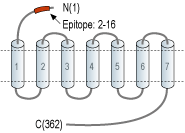Overview
- Peptide (C)DVHLFDYVEPGNYSD, corresponding to amino acid residues 2-16 of rat CXCR7 (ACKR3) (Accession O89039). Extracellular, N-terminus.

 Expression of CXCR7 in mouse olfactory bulb.Immunohistochemical staining of perfusion-fixed frozen mouse brain sections with Anti-CXCR7 (ACKR3) (extracellular)-ATTO Fluor-488 Antibody (#ACR-037-AG), (1:100). A. CXCR7 immunoreactivity (green) appears in neuronal profiles (arrows). B. Pre-incubation of the antibody with CXCR7 (ACKR3) (extracellular) Blocking Peptide (#BLP-CR037), suppressed staining. Cell nuclei are stained with DAPI (blue).
Expression of CXCR7 in mouse olfactory bulb.Immunohistochemical staining of perfusion-fixed frozen mouse brain sections with Anti-CXCR7 (ACKR3) (extracellular)-ATTO Fluor-488 Antibody (#ACR-037-AG), (1:100). A. CXCR7 immunoreactivity (green) appears in neuronal profiles (arrows). B. Pre-incubation of the antibody with CXCR7 (ACKR3) (extracellular) Blocking Peptide (#BLP-CR037), suppressed staining. Cell nuclei are stained with DAPI (blue).
- Griffith, J.W. et al. (2014) Annu. Rev. Immuno. 32, 659.
- Sun, X. et al. (2010), Cancer Metastasis Rev. 29, 709.
- Burns, J.M. et al. (2006) J. Exp. Med. 203, 2201.
- Jones, S.W. et al. (2006) Osteoarthritis and Cartilage 14, 597.
- Miao, Z. et al. (2007) Proc. Natl. Acad. Sci. U.S.A. 104, 15735.
- Boldajipour, B. et al. (2008) Cell 132, 463.
Chemokines are molecules that control the migration and positioning of the immune system cells. In addition to their function as chemo-attractants they have various other roles in the maturation of immune cells such as T-cell development in the thymus and homeostatic retention of immune cells in the bone marrow1.
Chemokines bind to chemokine receptors, members of the G-protein coupled receptor superfamily. They are comprised of seven transmembrane receptors with extracellular N-terminus, three extracellular and three intracellular loops and an intracellular C-terminus. One of the intracellular domains of the receptor couples with G proteins and begins a cascade of signal transduction2.
Until recently the CXCR-7 was an “orphan” receptor with its endogenous ligand unknown. This receptor is encoded by the CXCR7/RDC-1 gene which was mapped to mouse chromosome 1 and human chromosome 2. Homology has been shown with the viral gene ORF74 suggesting the receptor might signal without the binding of a ligand. Currently it is known that the chemokines CXCL12 and CXCL11 bind to CXCR-73.
CXCR-7 is tightly linked to the regulation of B cell development and differentiation indicating it might have a role in the formation of B memory cells4. CXCR-7 was also found to be associated with tumors where its levels are elevated in many tumor cell lines such as endothelial cells, fetal liver cells and placenta cells5. Despite this suggested role, there is growing evidence that this receptor does not function as a regular GPCR6.
Application key:
Species reactivity key:
Anti-CXCR7 (ACKR3) (extracellular) Antibody (#ACR-037) is a highly specific antibody directed against an epitope of the rat CXCR7 chemokine receptor. The antibody can be used in western blot analysis. The antibody recognizes an extracellular epitope and is thus ideal for detecting the receptor in living cells. It has been designed to recognize CXCR7 from human, rat and mouse samples.
Anti-CXCR7 (ACKR3) (extracellular)-ATTO Fluor-488 Antibody (#ACR-037-AG) is directly labeled with an ATTO-488 fluorescent dye. ATTO dyes are characterized by strong absorption (high extinction coefficient), high fluorescence quantum yield, and high photo-stability. The ATTO-488 label is analogous to the well known dye fluorescein isothiocyanate (FITC) and can be used with filters typically used to detect FITC. Anti-CXCR7 (ACKR3) (extracellular)-ATTO Fluor-488 Antibody is especially suited for experiments requiring simultaneous labeling of different markers.

